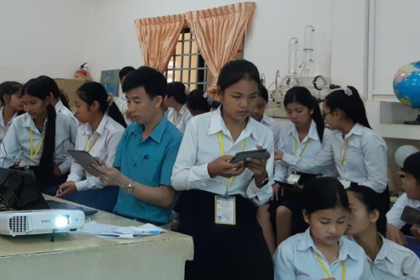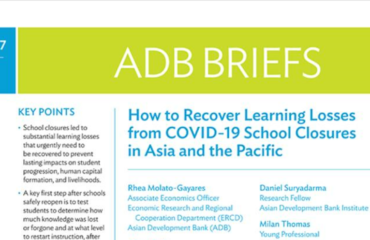
As part of its regular online briefings the ADB, in July, published How to Recover Learning Losses from COVID-19 School Closures in Asia and the Pacific[1], the paper makes a strong case for an approach to learning recovery that involves wholescale organisational change, not simply grafting on remedial measures to the existing broken systems – the recommendations embrace the use of technology, but they also point to the need for significant reorientations in curriculum design and a modernization in the way teachers operate.
Across the globe the Covid-related school closures since 2020 resulted in 170 million, or more students having no access to regular learning opportunities, with the consequential huge losses in learning. Across SE Asia, students’ school attendance was only around 80% of normal, between the first quarter of 2020 and the last quarter of 2021 resulting in the chances of meeting the UN Sustainable Development Goals for education slipping further away. Research by the Centre for Global Development[2] has shown how the learning losses associated with school closures have disproportionately affected the poorest and most socially disadvantages children.
The school closures served to reinforce the need to create alternatives to conventional models of schooling that consist of a teacher is in direct control of the learning of many students – often 50 or more, in a custodial classroom. Educational Technology (EdTech) has its part to play, but as we have seen, access to digital resources and the devices to use these resources is unevenly spread. Mass broadcast technologies, such as radio and TV, were used by many education ministries in SE Asia to promote remote learning, but these were often used to little effect as students lacked the learning skills to be able to drive their own learning and most teachers were unable to move away from their regular mode of transmissive delivery in lecture style. Nonetheless, there are a few examples of EdTech being used creatively to promote new learning. In Cambodia, students have benefited from hand-held tablet devices with access to digital resources to enhance their learning and understanding of the STEM subjects.
Whilst there have been some undoubted successes in using technology to overcome learning losses, in general, many teachers in the SE Asia region have struggled to integrate EdTech into their normal professional practice. It is not just a matter of low levels of digital literacy amongst the teaching workforce, more important in the shift to more learner-centric modes of education, which do not involve teachers directing learning at all times.
Encouraging students’ understanding about their own learning – so-called ‘metacognition’, and being able to drive and motivate themselves to make progress, is the single most influential and cost-effective means to raise standards. Empirical research by the Education Endowment Foundation (EEF)[1] in the UK in 2018 proved this most conclusively.
So, professional development, along with a reprioritization of the curriculum and enhanced integration have to be taken all together in a combined way to have the desired impact on school recovery. The ADB paper summarizes the steps to school recovery as follows:
- A key first step after schools safely reopen is to test students to determine how much knowledge was lost or forgone and at what level to restart instruction, after which attention should focus on regularly tracking the progress of learning.
- Teaching based on the student’s level, with the help of teaching assistants, tutors, or education technology (edtech), is crucial for learning recovery, as it has proven effective in improving learning outcomes.
- Prioritizing foundational skills, extending instruction time, and encouraging the re-enrollment of dropouts are also important for learning recovery.
- Quality in-service teacher training is needed to support changes in pedagogy.
The TIESEA project in its interventions in Cambodia, Indonesia, The Philippines and Viet Nam is following these steps in order to determine ‘what works in EdTech in SE Asia’. All of the country pilot projects have teacher professional development, and curriculum reform at the very center of the work – EdTech is then used as a tool to facilitate and promote the changes.
TIESEA will be feeding back the major findings at an international conference in the region in September 2023: watch this space, and follow these blogs for further updates!
[1] https://www.adb.org/sites/default/files/publication/808471/adb-brief-217-learning-losses-covid-19-school-closures.pdf
[2] Moscoviz, L. and D. K. Evans. 2022. Learning Loss and Student Dropouts During the COVID-19 Pandemic: A Review of the Evidence Two Years after Schools Shut Down. CGD Working Paper. No. 609. March. Washington, DC: Center for Global Development.
[3] https://educationendowmentfoundation.org.uk/public/files/Toolkit/complete/EEF-Teaching-Learning-Toolkit-October-2018.pdf

